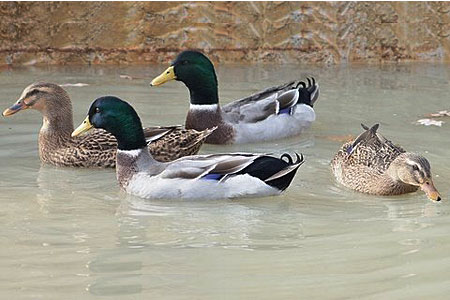
Ducks, like other birds, periodically replace their worn-out feathers with a full set of fresh plumage in a process called molting. Young ducks go through two consecutive molts. After maturity, the hens renew their feathers annually, while the drakes go through two annual plumage changes —the eclipse and nuptial molts. Most domestic duck breeds in the United States, which derive from the wild mallard, molt similarly.
Juvenile Molts
By the end of their first week of age, ducklings develop distinguishable little wings. By the end of the second week, they have tail feathers. Body feathers come in during the third week and fill out in the fourth week. By the end of the fifth week most of the juvenile feathers are in. By 6 to 8 weeks of age the little guys fully feather and look like miniature ducks
Just about the time they have all their feathers, they go through a partial molt—that is, some of their feathers drop out sequentially and new feathers replace them. Young adult plumage is typically complete by the time they are 4 to 5 months of age.
During these two molts, the growing ducks look pretty much like they will at full maturity. An exception is the Welsh Harlequin, which looks completely different with each new set of plumage. The first is the drabbest. The second includes more white feathers than the ducks will have as adults.
Eclipse Molt
After these two early molts, ducks experience one complete molt each year. This molt is the eclipse or basic molt. It generally occurs in late summer or early fall after the nesting season but before cold weather sets in.
During the eclipse molt, Mallard drakes, like their wild counterparts, take on the camouflage pattern of the females. This color pattern lets the drakes more easily hide while they are vulnerable to predators.
Unlike chickens and most other birds, which lose their flight feathers one at a time, during the eclipse molt Mallards drop all 10 primary wing feathers at the same time. So they can’t fly for some three to five weeks while the feathers grow back.
Nuptial Molt
Just before breeding season, the drakes go through a second, partial, molt that restores their more colorful plumage. This molt is the nuptial molt.
For Mallards and other brightly colored breeds in which males and females have distinctly different plumage patterns, the change between eclipse and nuptial molts can be quite dramatic. Breeds in which males and females do not differ in color, such as Pekins and Cayugas, the difference is barely noticeable.
During the Molt
All the ducks in a single flock may not molt on the same exact schedule or take the same amount of time to complete the molt. However, ducks that molt entirely out of season may have experienced a stressful change in their environment, diet, or state of health that should be investigated.
During the molt, ducks scratch and preen more than usual. They may also become uncharacteristically crabby. Females that are laying will decrease production, or stop laying altogether. That’s because the energy they normally use for producing eggs goes into producing feathers instead.
Since feathers consist mainly of protein, molting ducks will benefit from a protein supplement. Good sources of supplemental protein include dried mealworms and crickets, and high-protein game bird or turkey layer rations. Supplemental animal protein not only helps ducks through a molt, but also improves the plumage of those destined for exhibition.
And that’s today’s news from the Cackle Coop.
Gail Damerow is the author of An Absolute Beginner’s Guide to Raising Backyard Ducks : Breeds, Feeding, Housing and Care, Eggs and Meat.

